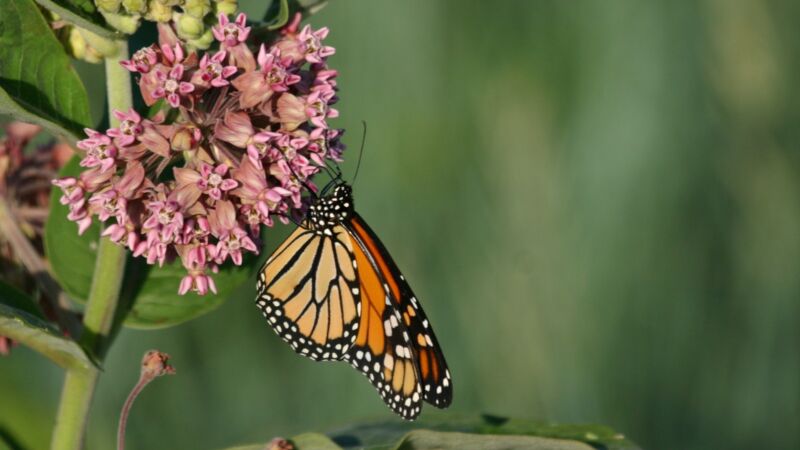
The content in this article is copied and summarized from the Environmental Protection Agency’s Risk Management Approach to Identifying Options for Protecting the Monarch and Notice of Availability and Public Comment Opportunity for purposes of raising awareness about the public comment period on these documents.
What is this document all about?
The US Environmental Protection Agency has made their management approach for understanding and identifying protections for the monarch butterfly available for comment. The comment period has been extended to August 24th, 2015. You can submit comments by clicking the green "Submit a Formal Comment" button on this page. The full approach can be viewed here.
The document outlines the EPA’s approach to reviewing direct and indirect effects of pesticide (including herbicide) application on monarchs and determining which herbicides to consider in the scope of this action.
The EPA envisions working with diverse stakeholders to identify information about monarchs and milkweed, and using that information to collaboratively identify activities that will balance weed management needs with milkweed conservation. The success of these initiatives will be dependent on interaction between partners of different sectors to adopt management practices in a coordinated manner not only at the field level, but at the landscape level and area-wide level as well.
What is it the EPA would like public comments on?
The agency is requesting public comments on the information they propose to use in their approach and on which conservation actions would be most effective in reducing impacts of herbicides on monarchs.
To determine which herbicides to include in the scope of action, the EPA proposes to evaluate the following information:
- volume of use of various herbicides on acreage in agricultural production and in nonagricultural areas such as rights-of-way, pastures/rangeland, forestry sites, and industrial areas where the milkweed plant is commonly found;
- information on the monarch butterfly such as its lifecycle, seasonal distribution, population demographics over time, and modeling analyses relevant to critical life stage parameters to which the monarch butterfly population is most sensitive;
- laboratory or field data that specifically relates to the effects of various herbicides on the milkweed plant species;
- spatial and temporal parameters of weed management needs with respect to different land use categories and herbicide uses; and in agricultural areas where herbicide use may overlap with habitat of the monarch butterfly development, reproduction, and migration;
- and information on existing practices that promote co-occurrence of agricultural production with maintenance of milkweed populations.
If appropriate, the strategies outlined in the EPA approach could be considered risk mitigation for herbicides that adversely impact the monarch butterfly. The EPA approach proposes the following potential actions:
- requiring changes to label instructions such as: lowering the rates, decreasing the frequency; modifying the timing of applications; or establishing spray drift buffers in fields that are treated with herbicides in order to protect critical milkweed resources.
- supporting education and training on best management practices, in addition to and complementary of other efforts to create, conserve or restore wildlife habitat.
- undertaking conservation banking effort(s) that could establish, preserve, or restore habitat for monarch butterflies, or cooperative efforts to fund further research into protection measures for the monarch butterfly.
EPA is soliciting public comment on what information to consider, and which potential action or a combination of actions would be the most effective in reducing the impacts of herbicides on the monarch butterfly. The agency is also requesting that any additional measures not discussed here be identified. You can submit comments through this website by clicking the “Submit a Formal Comment” button.
Why is the EPA proposing an approach to protect monarchs?
EPA is initiating efforts focused specifically on the monarch butterfly for several reasons. The approach and objectives outlined in Risk Management Approach to Identifying Options for Protecting the Monarch Butterfly will support and complement the actions and objectives of previous federal actions.
First, the U.S. is engaged in an effort with Canada and Mexico through the Trilateral Committee for Wildlife and Ecosystem Conservation and Management, where the three partner nations have agreed to make natural resource conservation a priority.
Secondly, President Obama issued a memorandum on pollinator protection. The memorandum highlights the importance of the monarch butterfly and establishes a task force of Federal agencies to develop a strategy to conserve pollinators and monarchs in particular.
Finally, in February 2014, EPA's Office of Pesticide Programs (OPP) received a petition from the Natural Resources Defense Council (NRDC) asking EPA to take actions to reduce the use of the herbicide glyphosate because NRDC believes that the widespread use of glyphosate has impacted the monarch butterfly by reducing the presence of the milkweed. While EPA has denied NRDC's petition, EPA concludes that its ongoing efforts to protect bees, in conjunction now with this effort to protect the monarch butterfly, are in line with the objectives of the NRDC petition.
In addition, together with several non-governmental organizations, various agencies within the Federal government have been working collaboratively with the Monarch Joint Venture to develop and implement measures to protect monarch butterflies and their migration.
The content in this article does not necessarily reflect the positions of all Monarch Joint Venture partners.
